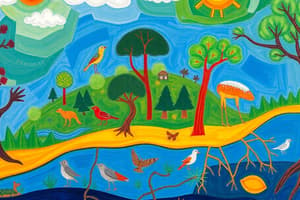Podcast
Questions and Answers
What role do decomposers play in the nutrient cycle?
What role do decomposers play in the nutrient cycle?
- They release oxygen into the atmosphere.
- They provide energy to herbivores.
- They break down dead organic matter. (correct)
- They consume living plants.
Which statement is true about malaria?
Which statement is true about malaria?
- It can be treated with antibiotics.
- It is caused by a bacterial infection.
- It is spread by a female mosquito-borne protozoan. (correct)
- It primarily affects the respiratory system.
What is the main characteristic of micro-organisms?
What is the main characteristic of micro-organisms?
- They are multicellular organisms.
- They can be seen with the naked eye.
- They are always harmful to other life forms.
- They reproduce quickly and are unicellular. (correct)
What is the primary symptom of tuberculosis?
What is the primary symptom of tuberculosis?
Which of the following diseases is caused by a virus?
Which of the following diseases is caused by a virus?
Which organelle is responsible for producing ATP through respiration?
Which organelle is responsible for producing ATP through respiration?
What is the main function of the cell membrane?
What is the main function of the cell membrane?
What process can be described by the equation CO₂ + H₂O → C₆H₁₂O₆ + O₂?
What process can be described by the equation CO₂ + H₂O → C₆H₁₂O₆ + O₂?
Which of the following best describes xerophytes?
Which of the following best describes xerophytes?
Which of the following terms describes an animal's ability to blend into its surroundings?
Which of the following terms describes an animal's ability to blend into its surroundings?
Which of the following statements accurately describes a food chain?
Which of the following statements accurately describes a food chain?
What role do decomposers play in a food web?
What role do decomposers play in a food web?
Which of the following best defines a trophic level?
Which of the following best defines a trophic level?
What characterizes heterotrophs in an ecological context?
What characterizes heterotrophs in an ecological context?
Which of the following is NOT a type of consumer?
Which of the following is NOT a type of consumer?
Which term describes a relationship where both organisms benefit?
Which term describes a relationship where both organisms benefit?
What is the primary function of producers in an ecosystem?
What is the primary function of producers in an ecosystem?
Which of the following best describes biodiversity?
Which of the following best describes biodiversity?
Flashcards are hidden until you start studying
Study Notes
Food Webs and Food Chains
- Energy is transferred from producers to consumers.
- Arrows in a food chain represent energy transfer.
- Decomposers are the final link in a food chain.
- Producers create their own food using photosynthesis.
- Consumers consume other organisms for food.
- Omnivores eat both plants and animals.
- Herbivores eat only plants.
- Carnivores eat only animals.
- Insectivores eat only insects.
- Scavengers eat dead animals and plants.
- Decomposers break down dead organic matter.
- Photosynthesis formula: $CO_2 + H_2O → O_2 + C_6H_{12}O_6$
Ecological Terms
- Individual: One living organism.
- Population: A group of individuals of the same species.
- Community: A group of different populations living together.
- Ecosystem: All communities and their environment (biotic and abiotic).
- Biosphere: All ecosystems.
- Biodiversity: Variety of life in an ecosystem.
- Habitat: An organism's living area.
MRS GREN Notes
- Movement: Moving from one place to another.
- Reproduction: Creating more of the same organism.
- Sensitivity: The ability to perceive and respond to the environment.
- Growth: An increase in size or weight.
- Respiration: The process of converting glucose into energy (ATP).
- Excretion: The elimination of waste products.
- Nutrition: Obtaining food (animals) or producing it (plants).
Cell Structure and Function
- Cell Membrane: A thin, flexible layer that controls what enters and leaves the cell.
- Cytoplasm: Where chemical reactions occur, such as photosynthesis.
- Nucleus: The control center of the cell, containing DNA.
- Mitochondria: The site of ATP production through respiration.
Processes
- Respiration: C₆H₁₂O₆ + O₂ → ATP + H₂O + CO₂
- Photosynthesis: CO₂ + H₂O → C₆H₁₂O₆ + O₂
Environmental Adaptations
- Xerophytes: Adapted to dry environments.
- Hydrophytes: Adapted to wet environments.
Animal Adaptations
- Camouflage: Blending in with surroundings.
- Mimicry: Resembling another animal or object.
Nutrient Cycle
- Decomposers break down dead organic matter, releasing minerals into the soil.
- Plants take up minerals from the soil for growth.
- Dead leaves contribute to the soil's nutrient content.
Disease Caused by a Protozoan
- Malaria: Caused by the protozoan Plasmodium, transmitted by mosquitoes.
- Symptoms: High fever, chills, shaking, sweating, muscle aches, headaches, vomiting.
- Treatment: Prophylactics (preventive medicine) for Plasmodium.
Waterborne Diseases
- Spread through contaminated water.
Disease Caused by a Virus
- HIV/AIDS: Human Immunodeficiency Virus causes Acquired Immunodeficiency Syndrome.
- Management: Healthy lifestyle and ARVs (Antiretroviral Medicines).
- Symptoms: Fever, aches, sore throat, swollen glands.
Disease Caused by Bacteria
- TB (Tuberculosis): A lung infection.
- Treatment: Long-term antibiotics use.
- Symptoms: Coughing blood, fever, weight loss, night sweats.
Micro-organisms
- Unicellular and microscopic.
- Reproduce quickly.
- Found in water, air, soil, and inside/outside living organisms.
- Types:
- Non-cellular: Viruses (not included in MRS GREN).
- Monera: Bacteria (included in MRS GREN).
- Protista: Protozoans and algae (included in MRS GREN).
- Fungi: Mushrooms, yeasts, and molds (included in MRS GREN).
- Plantae and Animalia: Larger organisms.
Studying That Suits You
Use AI to generate personalized quizzes and flashcards to suit your learning preferences.




